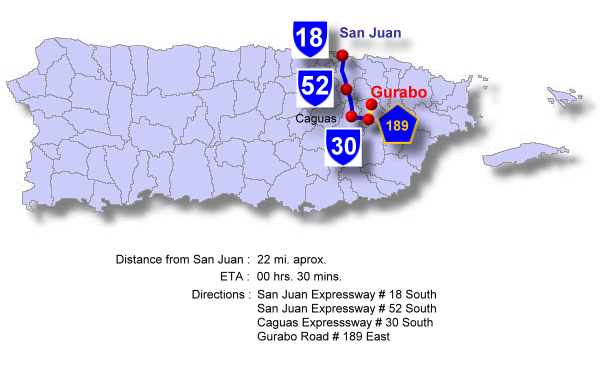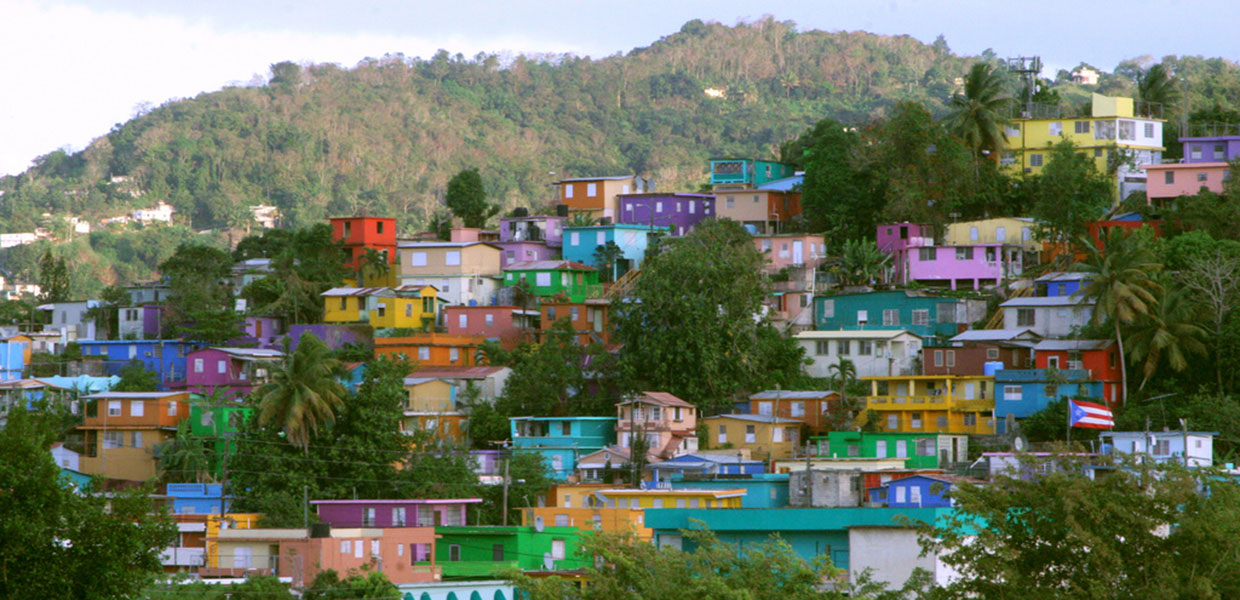
Gurabo, Puerto Rico
Town of Stairways
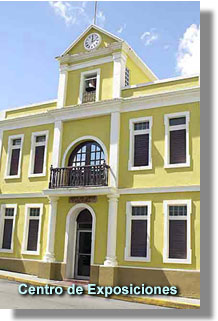 Gurabo (goo-RAH-bo) is known as the “town of the staircases”, because of the extensive and colorful stairways located in the town. The nickname for residents is “gurabeños”.
Gurabo (goo-RAH-bo) is known as the “town of the staircases”, because of the extensive and colorful stairways located in the town. The nickname for residents is “gurabeños”.
The municipality of Gurabo is located in the east-central part of Puerto Rico. It is bordered by Trujillo Alto on the north, San Lorenzo on the south, Carolina and Juncos on the east and Caguas on the west. It is part of three distinct geographic regions.
The southern portion is part of the eastern mountainous zone. The northern part is within the humid foothills of the north, and central area is part of the Caguas Valley. This is the largest of the interior valleys on the island. It formed as a result of erosion by the Gurabo River, the Grande de Loíza River and the Valenciano River. The soil in the valley is very fertile.
This town has been one of the fastest-growing municipalities in recent times. This is because Gurabo has become a suburb of the San Juan metropolitan area, as the majority of its residents work in the capital.
The principal economic activity is manufacturing, with metal, paper, plastic, chemicals, pharmaceuticals, textiles, machinery and electronic equipment being the main products. Farming and livestock are also part of the municipality’s economy. Fruit and tobacco are the main crops. Some sugar cane, a very important product in the town’s economic history, is still grown.
Foundation:
Before Gurabo was declared an independent municipality it was Burabo, a district of Caguas. This district was distant from Caguas, which caused transportation problems during the eighteenth century. Caguas could not take care of the problems of their neighbors in this district.
In 1812 the residents of Gurabo decided to take action on this matter. The 168 heads of family who lived in the district met to discuss their problems. They decided to declare themselves orphan of all medical, ecclesiastical, and judicial authority. They complained of not receiving municipal services, and because of the significant number of inhabitants, they were entitled to better economic and social considerations. In this meeting, power was granted to Don Luis del Carmen Echevarría to manage the foundation of the new town, obtaining this in 1815. Seven years later, in 1822 the town erected canonically its own parish under the advocation of Patriarch San José.
Location:
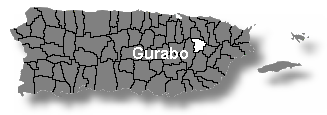 Located in the central eastern region, it is bordered by: Trujillo Alto on the north, San Lorenzo on the south, Caguas on the west, and Carolina and Juncos on the east.
Located in the central eastern region, it is bordered by: Trujillo Alto on the north, San Lorenzo on the south, Caguas on the west, and Carolina and Juncos on the east.
Area:
73.0 sq km / 28.0 sq mi
Population:
36,743 (census 2000)
Population Density:
503.3 per sq km / 1,312.2 per sq mi
People are known as:
Gurabeños
Gurabo is also known as:
El Pueblo de las Escaleras (Town Of Stairways)
Puerta del Turismo del Sureste (The Southeastern Tourism Gateway)
Wards: Gurabo, Puerto Rico
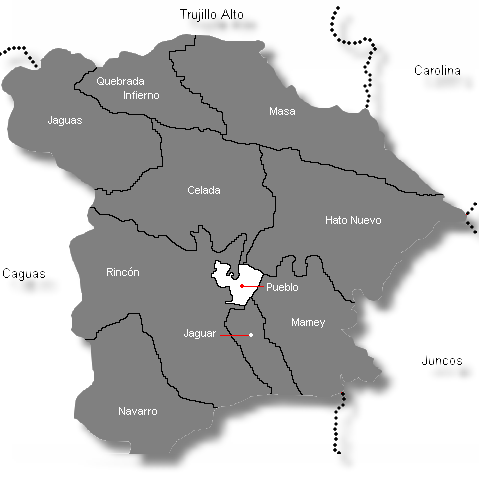
| Census 2000: Population by Wards - Gurabo |
Habitants |
| Celada | 2,288 |
| Gurabo Pueblo | 1,960 |
| Hato Nuevo | 7,377 |
| Jaguar | 810 |
| Jaguas | 2,075 |
| Mamey | 4,203 |
| Masa | 1,677 |
| Navarro | 5,015 |
| Quebrada Infierno | 675 |
| Rincón | 10,663 |
| Total | 36,743 |
Source: Censo 2000
Patron:
San José
San José Parish
Apartado 733
Gurabo, Puerto Rico 00778
(787) 737-2656
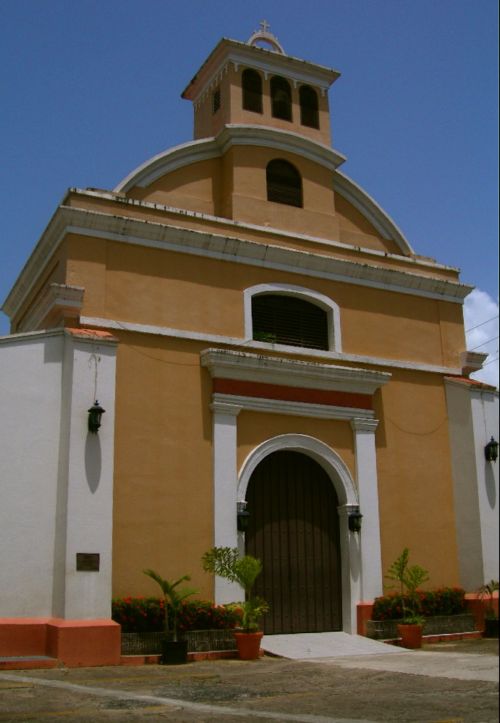
Topography:
Gurabo belongs to the Caguas Valley region. To the north it contains the Cuchilla de Hato Nuevo, whose culminating point in Gurabo territory is the Silla Hill (Masa Ward), with 367 meters (1,204 feet) of altitude. In the southeast (Mamey Ward) it has other smaller elevations corresponding to the Sierra de Cayey.
Hydrography:
The Grande de Loíza River serves as the border with the municipality of Caguas and its affluent is the Gurabo River. Some gorges that water this municipality and affluents of the Grande de Loíza River are the Grande, Infierno and Maracuta gorges.
Climate:
Average high temperature is 87.0º F, the low is 65.5º F and the average annual rain is 63.35 inches.
Economy:
Manufacturing (metal, paper, plastics, chemistries, phamaceuticals, textiles, electrical and electronic equipment, and electrical machinery) and agriculture (dairy farms).
Flag:
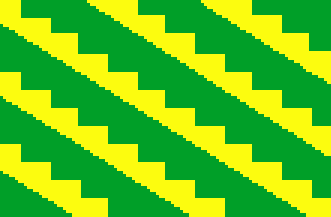 With eleven stripes, six green and five yellow, alternated, the yellow with the superior (top) edge indented forming a stairway. Each step measures two units high by three wide. The flag has the main colors of the municipal Coat of Arms, green and gold representing the metal, in this case by the color yellow, and its design alludes to the five stairways characteristic of the urban profile of the population.
With eleven stripes, six green and five yellow, alternated, the yellow with the superior (top) edge indented forming a stairway. Each step measures two units high by three wide. The flag has the main colors of the municipal Coat of Arms, green and gold representing the metal, in this case by the color yellow, and its design alludes to the five stairways characteristic of the urban profile of the population.
Coat Of Arms:
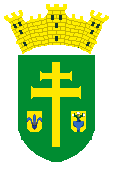 In a green field resides a widened gold patriarcal cross. Below the bottom arm are two shields in silver. The one on the left has a fleur de lis and the one on the right three lilies with stems in a natural way. Three towers in gold crown the shield.
In a green field resides a widened gold patriarcal cross. Below the bottom arm are two shields in silver. The one on the left has a fleur de lis and the one on the right three lilies with stems in a natural way. Three towers in gold crown the shield.
Places To Visit:
- Exhibition Center
- El Cerro
- Former City Hall and Clock
- San José Parish
- Luis Muñoz Marín Plaza
- Mirador Estate
- Loíza Lagoon
- University of Turabo Museum
- Cofresí Park
Events:
- Home Garden Festival (May)
- Youth Festival (May)
- Mapeyé Festival (October)
- San José Patron Saint Festival (March)
Distinguished Citizens:
- Luis del Carmen Echevarría – Mayor in 1812, 1823, 1826, 1833. Founded the town of Gurabo in 1815.
- José Emilio González – Poet, essayist, journalist and college professor. Honored by the Institute of Puerto Rico Culture and the Puerto Rican Athenaeum.
- Nilda González Monclova – Script writer, actress and professor at the University of Puerto Rico.
- Angel Celestino Morales – Writer. He wrote in multiple genres.
- Angel Viera Martínez – Lawyer and politician. Founding member of the New Progressive Party, representative to the Assembly (1969-1985); vice president of the New Progressive Party (1983). Along with Dr. Hernán Padilla, founded the Puerto Rican Renovation Party.
- Harry Colón Díaz – Defender of the environment and nature. Recognized for his community work in Santa Rita and Masas in Gurabo.
Public Schools sorted by educational levels.
Humacao Region
Gurabo District
| Name | Level | Telephone | Address |
| Elementary | |||
| CELADA CARRETERA | K-6 | (787) 737-4346 | PO Box 1131, P.R. 00778-0000 |
| HATO NUEVO | K-6 | (787) 737-4347 | PO Box 1335, P.R. 00778-0000 |
| JAGUAS | K-6 | (787) 737-6066 | PO Box 1369, P.R. 00778-0000 |
| LUIS MUÑOZ RIVERA | PK-3 | (787) 737-2216 | PO Box 1364, P.R. 00778-0000 |
| MARGARITA RIVERA DE JANER | 4-6 | (787) 737-6594 | PO Box 879, P.R. 00778-0000 |
| MAXIMINA MÉNDEZ | K-6 | (787) 737-8366 | PO Box 1359, P.R. 00778-0000 |
| VILLA MARINA | K-6 | (787) 737-4344 | PO Box 580, P.R. 00778-0000 |
| Intermediate | |||
| MATÍAS GONZÁLEZ GARCÍA | 7-9 | (787) 737-2056 | PO Box 1346, P.R. 00778-0000 |
| Secondary | |||
| SU JOSEFINA SITIRICHE | K-9 | (787) 737-2626 | PO Box 38, P.R. 00778-0000 |
| SU SANTA RITA | K-9 | (787) 737-6222 | HC 1 BOX 4226, P.R. 00778-0000 |
| SU VIDAL SERRANO | K-9 | (787) 747-2323 | PO Box 1090, P.R. 00778-0000 |
| High School | |||
| DRA. CONCHITA CUEVA | 10-12 | (787) 737-2700 | PO Box 1293, P.R. 00778-0000 |
Hymn:
By Miguel Monserrate
En un valle rodeado por montañas nace un
pueblo de entre el barro.
Con valor fue creado por hombre de fe
y constancia para honrar
y alabar al Creador.
En Gurabo un pueblo con mucho orgullo
de costumbres de cultura y devoción
donde el tiempo se detiene ante el arrullo
de su gente de su historia y tradición.
CORO
Gurabo es mi pueblo, es mi hogar,
es mi vida, es mi orgullo, es mi cantar,
es mi música, es mi sueño, es mi luchar...
mi instrumento de alegría y mi soñar.
Gurabo es mi pueblo, es mi hogar,
escalera al paraíso terrenal
de las voces de su gente surge el himno
que se cantará por toda la eternidad.

